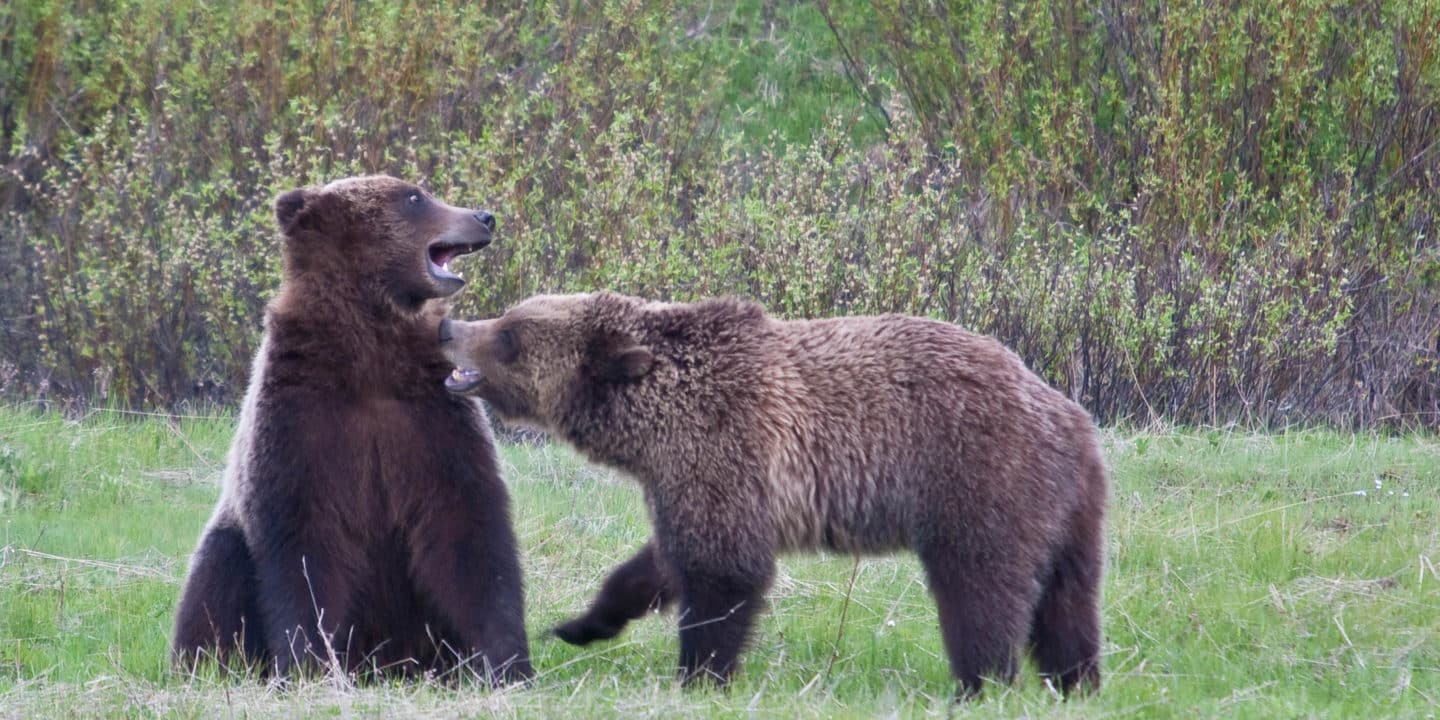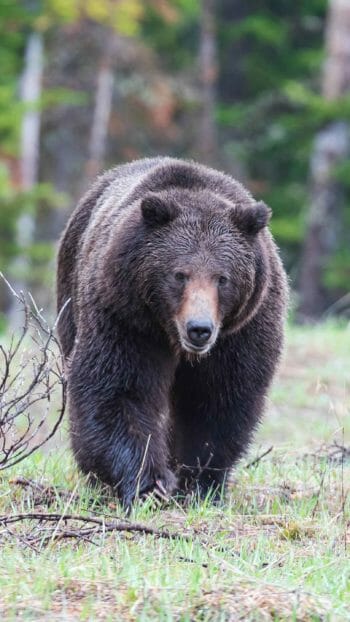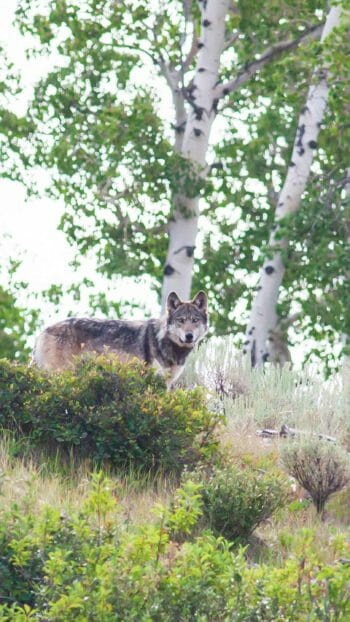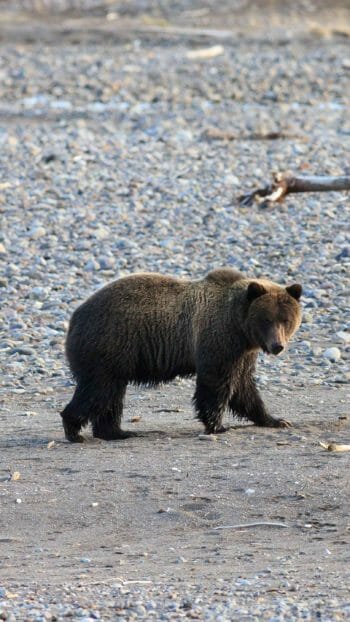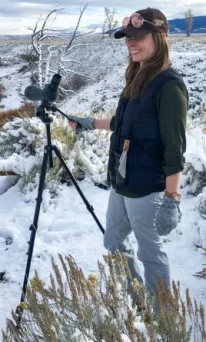Eight species of bears can be found around the globe, varying in sizes from 60 lbs to almost 1,000 lbs, from four feet to eight feet tall, inhabiting ecosystems of varying climates. Here in Yellowstone, we have our very own subspecies of the brown bear, famously known as the grizzly bear. Brown bears earn the name ‘grizzly’ when they live in the interior, as opposed to the “coastal brown bear” found in Alaska, which is the same species. Our Yellowstone grizzly bear was among the first to be listed on the Endangered Species List in 1975. They were briefly delisted in the summer of 2017 but were relisted only a year later and are currently considered endangered. The Yellowstone grizzly has had a lot of recovery to do since the arrival of settlers in the 1800s, which extirpated them from 98% of their original range. Currently, their population is estimated at around 1,000 individuals in the Greater Yellowstone Ecosystem (GYE), and wildlife managers are pleased with their progress.
In addition, we also have the American black bear. In contrast to the grizzly, their population has no official number; they are considered “plentiful.” Their numbers grow more easily because they reproduce more often and require less space than grizzlies.
The habits of bears constantly change throughout the year, depending on the season. The needs of a bear in spring vary significantly from their needs in the fall, and they follow an annual pattern that carries them through successful mating, raising cubs, and surviving the winter.
Spring
Spring is arguably the best time to view bears in Yellowstone. Imagine you wake up from a slumber that has spanned several months. You’re going to be very hungry. However, just as you wouldn’t feed somebody a large, heavy cheeseburger with large fries and a milkshake if they’ve been lost in the woods, weak with starvation for several weeks, bears also don’t just dive right into regular eating habits. They need to wake up their digestive system and their metabolism gently. They do this by first roaming their home range to get things moving again for about a week or two between the months of March and April. Male bears (boars) emerge first, and female bears (sows) with cubs later. They munch on grass mostly during this time as a slow reintroduction of food into their systems. From there, they graduate to digging up caches of seeds stored by pocket gophers. As the snow melts, they will make use of winter-killed animals, which are generally ungulates (elk, deer, bison) that are now exposed and available for scavenging, which is a significant source of protein for them.
Spring is the time for a new life, with many animals giving birth. Bears will take advantage of this as another important source of nutrition. Elk and deer are born almost completely scentless, so no predators can detect them by smell. The calves and fauns instinctively lay in tall grasses or bushes and stay completely still, barely even blinking. They are trying to be invisible (side note: if you come across a deer fawn or an elk calf that looks like it’s been abandoned, do not touch it! The mother is most likely nearby feeding and will return to it). Bears know this, however, and since they can’t use their fierce sense of smell, they will spend time combing through tall grasses and bushes in a strategic grid-like pattern to look for them.
Bears are also more visible during this time because snow is still deep in higher elevations, keeping them out of the mountains. They will spend much of their time searching for these food sources in open fields. This also helps them search for a mate. The reproductive system of a bear is fascinating. They have what we call delayed implantation, which is a vital process that allows them to execute their annual routines. If we look at other animals in Yellowstone, most of them will mate in the fall. This allows the female to be pregnant through the winter to give birth in the spring, right as rich food sources are coming back. This gives their young as much time as possible to grow strong enough for their first big challenge: making it through their first winter. Bears, however, do things very differently. They will mate in May and June, but the female’s body will store these fertilized eggs rather than implanting them in the uterus. She doesn’t become pregnant yet.
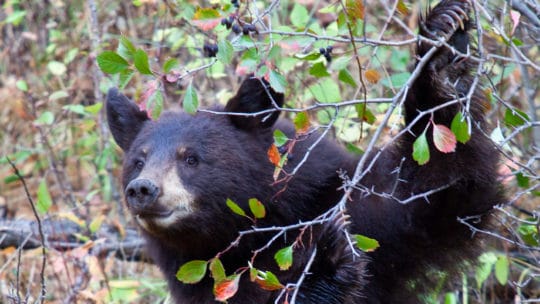
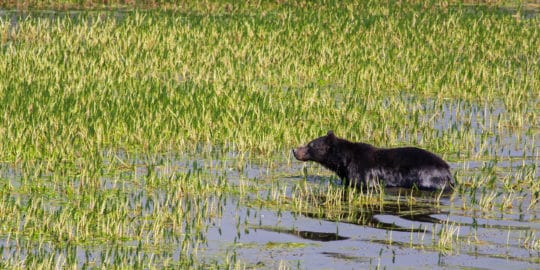
Summer
Summertime is when bears become more scarce and more difficult to see. It is getting hotter, and wearing a thick fur coat all the time doesn’t make you want to be very active in the sun. They follow crepuscular patterns during this time, which means they are more active in the morning and evening hours when it is cooler, and slow down considerably to avoid overheating. They spend more time in the shade, which means they are in wooded areas making it harder to spot them. They tend to move higher up in elevation and spend much of their time flipping over boulders to feed on army cutworm moth larvae living underneath. Amazingly, this will sustain a bear for some time. They also feed on various vegetation such as dandelion, cow parsnip, clover, a variety of wildflowers, ants, biscuit roots, fireweed, and much more. A bear’s diet consists of at least 266 species between plants and animals; about 80% of their diet is vegetation.


Fall
Fall is when things start to ramp up again for our bears as the temperatures cool and another winter is on the horizon. This is the season for berries, and berries mean bears! Huckleberries, serviceberries, buffaloberries, chokecherry, hawthorn berry, and many more are on the menu for the fall months, and it is an open buffet. Bears are entering hyperphagia, as mentioned earlier, which is a phase in which bears are spending all of their waking hours eating to pack on the pounds: 2-3 pounds per day! It is an eating marathon when they even sacrifice sleep to single-mindedly search for food and consume up to 20,000 calories in a single day. They are so laser-focused on this task that they can wander further from their usual ranges and become more visible to park visitors. This is also when you should be more bear aware on hikes as crossing paths with one gorging themselves on berries is more likely.
For our sows that are still holding on to those fertilized eggs from the spring, their success through this process will determine their pregnancy.


Winter
With winter on its way again, bears will begin to search for the ideal spot to dig their dens. If they find a suitable cave or hollow, they may occupy that, but typically they excavate a fresh hole in the ground. They often choose spots at the base of large trees, and on north-facing slopes to ensure adequate snow coverage of the entrance to maximize insulation. The entrance is usually just enough for them to squeeze into a short tunnel and a chamber where they sleep. They can move up to a ton of dirt and debris to construct the den.
A certified safari guide recently captured a video of a black bear doing just that in November, the ideal time black bears hibernate in Yellowstone. The bear—which will rest until mid-March—gathered grass, sticks, and dirt to build its bed and insulate its den. The video ends with the bear tucked nicely into its home, where it will stay for the next few months. We can’t wait to see it reemerge come spring!
This is the time that our grizzly sows have been working towards. Their body still has the fertilized eggs from mating in the spring, and now her body will assess their health going into hibernation. Several factors are considered, such as her age and her weight after hyperphagia, and this is how her body decides how many eggs to implant in her uterus. Basically, the more experienced and healthy a bear is, the more cubs she can potentially have. If she is struggling, she will eliminate all the eggs and skip motherhood that year to focus all her energy on herself. If she’s experienced and healthy, it is possible for her to have up to four cubs. The typical number of cubs for a bear to have is two.
Many people know that bears hibernate, but most do not know that they are not true hibernators. While animals like ground squirrels and marmots are “true” hibernators (who hibernate up to 8 months out of the year), bears can actually wake up depending on winter conditions and exit their dens mid-winter. They also alter their hibernation times depending on temperature and snowfall. They slow their heart rate down to just a few beats per minute, their oxygen usage drops dramatically, and their metabolism slows almost to a stop. They do not defecate or urinate during this time. They do, however, give birth in their dens. Around January, the bear will wake up to give birth to her cubs and nurture them in the den before emerging with their new litter, later than male bears. This means their gestation is technically only about two months long, even though they mated about eight months before birth!
Hibernation is an adaptation to harsh climates and low food resources. Only mothers with cubs hibernate in areas like northern Florida, where black bears are found. Most bears in that region don’t need to, as resources are still available. Yellowstone has some of the harshest winters in the lower 48, so hibernation is necessary for survival.
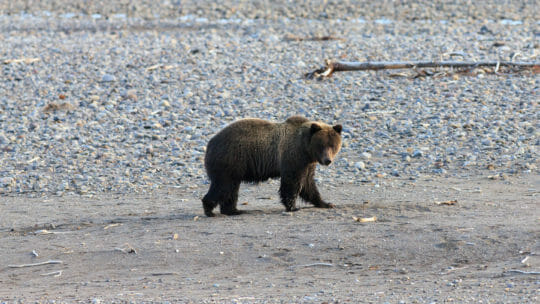

Going with a Guide
Like most visitors to Yellowstone, you will probably be most excited about the possibility of spotting a bear, particularly a grizzly bear, since there aren’t many other places to observe them. Even during the seasons when sightings are more likely, it is never a guarantee. Wildlife does its own thing, and we are lucky for every encounter we can have with them as they go about their natural behaviors. Going with a guide will significantly increase your chances of a bear sighting as we know their habits, which areas they frequent, and we know their latest activities as we are in the field so often. We also talk to each other! The more eyes out in the parks, the better, and we help each other out.
Going with a guide also ensures that you are viewing responsibly. The law in the parks is to stay 100 yards from bears. This is both for our safety and for the respect of our animals so that we do not disturb their natural behaviors. We want to watch them do what bears do, not influence their behaviors. Yellowstone is such a special ecosystem that supports both black and grizzly bears, and we would love to help you experience viewing them in their most natural and wild state! With a guide, you’ll be with someone who knows the right and wrong things to do around these animals, and you’ll get a wonderful interpretation of the behaviors you’ll see.
FAQs
How many bears are in Yellowstone?
Yellowstone is home to an estimated 150-200 grizzly bears within the park and around 700–1,000 in the Greater Yellowstone Ecosystem, along with a healthy population of black bears. Spotting a bear in Yellowstone is a highlight for many visitors, especially in areas like Lamar and Hayden Valleys. Always observe bears from a safe distance and follow park guidelines to protect both wildlife and visitors.
When is the best time to see bears in Yellowstone?
The best time to see a bear in Yellowstone is during spring (April–June) and fall (September–October). In spring, bears emerge from hibernation and are often seen foraging in meadows and valleys. Fall is another active period as they prepare for winter. Early mornings and evenings offer the highest chances of sightings, especially in areas like Lamar Valley, Hayden Valley, and along forested slopes.
What time of day are bears most active?
Bears in Yellowstone are most active during the early morning and late evening hours, especially in spring and fall. These cooler times of day are when they forage for food and move through open areas.
How likely am I to see a bear in Yellowstone?
While there’s no guarantee, chances of seeing a bear in Yellowstone are fairly good—especially during spring and fall in areas like Lamar Valley, Hayden Valley, and along forested roads. Grizzly and black bears are most active at dawn and dusk, and sightings are common for those who know where and when to look.
Are there grizzly bears in Yellowstone?
Yes, there are grizzly bears in Yellowstone. In fact, Yellowstone is one of the best places in the lower 48 states to see a bear in Yellowstone, including both grizzly and black bears.
What's the difference between a grizzly bear and a black bear?
The two main types of bear in Yellowstone are grizzly bears and black bears, and they differ in several ways. Grizzlies are generally larger, with a prominent shoulder hump, concave facial profile, and longer claws suited for digging. Black bears are smaller, lack the shoulder hump, and have a straighter profile and shorter claws for climbing. Despite their name, black bears can be brown, cinnamon, or even blonde—so color alone isn’t a reliable identifier.

